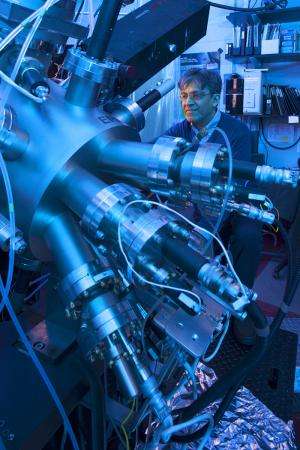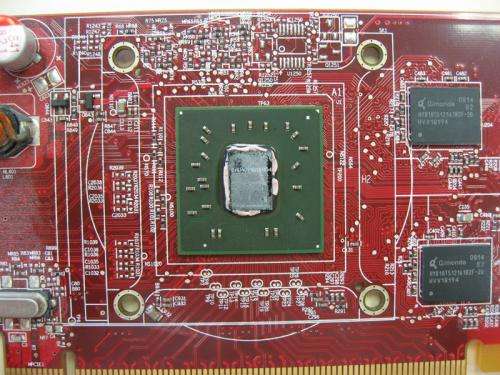Nitin Samarth, department head of physics at Penn State, works with the molecular beam epitaxy equipment in his lab. He conducts research to design and build new materials needed for radically new kinds of computer chips that could open the door to a new era of super-fast quantum computers. Credit: Fredric Weber, Penn State University
(Phys.org) —Remember when each new crop of computers was ever so much faster than the previous models? Well, those good-old days ended about five years ago when the accelerating rate of computing speeds crashed into the impenetrable wall of fundamental physics. The problem, according to Penn State Professor of Physics Nitin Samarth, involves electricity—specifically, the way computer components called transistors use electricity to compute. The solution he is working on is to develop new materials for radically new and super-fast kinds of transistors that rely on magnetism, instead of on the flow of electrons. This radically new way of computing is called "spintronics."
Samarth explained that today's technology for making computer processors run faster and faster involves shrinking the size of transistors so they can be packed together tighter and tighter onto a computer chip.
"The very fundamental limitation that stops computer manufacturers from making these chips faster is that the transistors are reaching the density at which the heat they generate cannot dissipate fast enough to prevent the computer from melting," Samarth said with a smile.
A transistor today is a small but essential computer component that switches the flow of electrons on and off. It is the flow of these electrons against the resistance of the surrounding materials that creates the troublesome heat. But computers do need transistors. Computers rely on the transistor's opposite options of "on" or "off" to carry out the type of mathematical logic that computers use in order to do what computers do. Computer logic uses just ones and zeros, which is how a computer interprets the on or off states of electron flow in a transistor.
So Samarth's goal is to give computers a new way to get their zeroes and ones. Instead of having electrons flow hotly through a transistor, Samarth is designing new kinds materials that will let the individual electrons be "cool" by just spinning in one of two opposite ways. "In one of those mysterious aspects of quantum mechanics, Nature allows the electron only to either spin up or spin down in the presence of a magnetic field," Samarth said. A computer chip that could harness these two new "spintronics" choices could open the door to a whole new era of ultra-fast, low-power-consuming computers.
Improvements in current-generation integrated circuits for computer processors are limited by the power, performance, and architectural constraints of conventional semiconductor technologies. Credit: Barbara Kennedy, Penn State University
"One of the interesting phenomena that people discovered in recent years is that you can change the orientation of an electron's spin just by using a voltage," Samarth said. "You are not back to creating heat-generating resistance inside a transistor by making the electrons flow, but rather you are just changing the orientation of their spin."
Integrating these entirely new spintronics transistors into a computer chip is one of the goals of C-SPIN, a large, new research effort centered at the University of Minnesota. This effort recently was funded by the U.S. Defense Advanced Research Projects Agency and the Semiconductor Research Corporation. Samarth is the Penn State Principal Investigator for the part of this project that is developing entirely new spintronics-ready materials that could support spinning electrons while functioning inside a computer.
To achieve this goal, Samarth's lab is doing experiments that construct new materials one atom at a time.
"It's a little bit like playing atomic-scale Legos," Samarth said. "We have two ultra-high-vacuum chambers that we use for a highly controlled process called molecular-beam epitaxy." The vacuum machines are huge, shiny, stainless-steel devices that take up much of the space in Samarth's one-room lab and look like something out of a sci-fi movie. Their noise makes the lab feel like it could be on a space ship.
"At first we create a very-high vacuum inside these chambers, then we deposit beams of selected kinds of elements in a very controlled way in order to deposit a layer of material that is the thickness of only one atom," Samarth said. "Because of the ultra-high vacuum, while one atomic layer is going down, nothing else is being deposited. So it is a very pure atomic layer of one element. We then can use a variety of different elements, plus the power of thermodynamics and chemistry, to engineer the crystal we want by building it up one atomic layer at a time."
Members of Samarth's lab also are measuring the propagation of electron spin in new types of semiconductor devices and are using the nanofabrication facility at Penn State to make the submicron-scale devices. "Like the components in modern computer chips, the highly specialized devices that we are fabricating here, which might function as spintronics transistors, typically are smaller than 100 times the width of one strand of your hair," Samarth said, "Facilities such as the Penn State nanofab are absolutely crucial to this type of research."
Provided by Pennsylvania State University






















